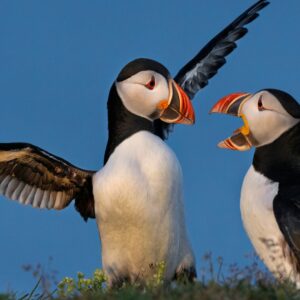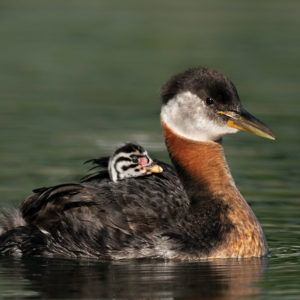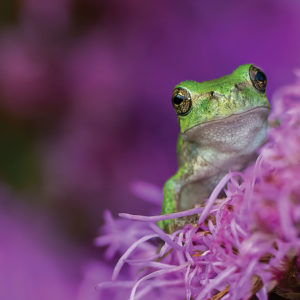High Climbers: Mountain Goats Earn Their Name
This month’s calendar image features one of Canada’s best mountaineers—but before you pack up your gear and run out the door, let us explain. These mountaineers are of the non-human variety, and are very good at keeping their distance at extremely high elevations. Not satisfied to simply stay in one place, this species can also jump nearly four metres, all while seemingly clinging onto the side of a near-vertical cliff. Similar to certain mountaineers, this animal can also sport a scraggly beard…
Have you guessed which species we’re talking about?
It’s the mountain goat! For April’s calendar image, Robert Berdan photographed a majestic adult and kid goat in a slightly less precipitous position. In Robert’s image, the two goats are seen standing on a rocky ledge near the TransCanada highway north of Field, British Columbia.
There are certain genetic adaptations that allow mountain goats to survive in the alpine and subalpine conditions of British Columbia, Alberta, and the Yukon. For example, they have thick wooly coats, cloven hooves, and horns. While these features may make the species resemble rugged farm goats, they’re actually more closely related to mountain gazelles, cattle, and antelopes. That’s right, mountain goats are not even goats!
Let’s dive a little deeper into the world of these great climbers…
Mountain goat hooves facilitate fancy footwork. Just as human rock climbers use their fingers to maneuver their way up a wall, mountain goat hooves have two toes that spread and allow them to grab onto small rocky features. This helps goats maintain their balance while roaming the mountains. Furthermore, the base of each toe is covered in a rough pad that creates a surface akin to climbing shoes.
While these are two of the more visible features allowing mountain goats to be tremendous mountaineers, there’s also a lot we can’t see. Studies have focused on a mountain goat’s ability to propel itself up cliffsides, and biologists attribute the skill to strong hindlimbs and specialized neck and and shoulder muscles.
Mountain goats climb for a reason. They face predation from bears, wolves, and cougars, especially when they remain close to forests and the tree line. Their high climbing skills don’t help with all predator encounters, however. Mountain goat kids are particularly danger-prone and can be plucked off cliff faces by eagles.
Mountain Showdowns
Mountain goats are far from helpless when it comes to defending themselves and their territory. Biologists have confirmed that mountain goats are more conflict-prone than most species, getting into three or four conflicts each hour. When conflicts do occur, mountain goats have been known to knock one another off cliffs and use their sharp horns as a dagger (and, though we don’t recommend observing this fun fact yourself, you can use the rings on their horns to determine a goat’s age).
The cliffside nature of mountain goat habitat means there isn’t always an abundance of food. As a result, mountain goats roam more commonly in small groups, and can get feisty if they detect another group of goats scoping out their source of grass, herbs, mosses, and ferns.
But mountain goats aren’t able to take on all showdowns. With shaggy coats and long beards, mountain goats are well-adapted for the cold alpine and subalpine conditions of Canada’s Rocky and Cascade Mountains. They struggle to survive in warm temperatures, however. As our climate changes and habitat and species abundance shift, goat habitat and feeding areas shrink alongside.
It’s up to Canadians to step up and defend mountain goats at times when they’re unable to protect themselves. Setting aside protected areas will help address the dual climate and biodiversity crises and ensure mountain goat species are able to continue thriving.



